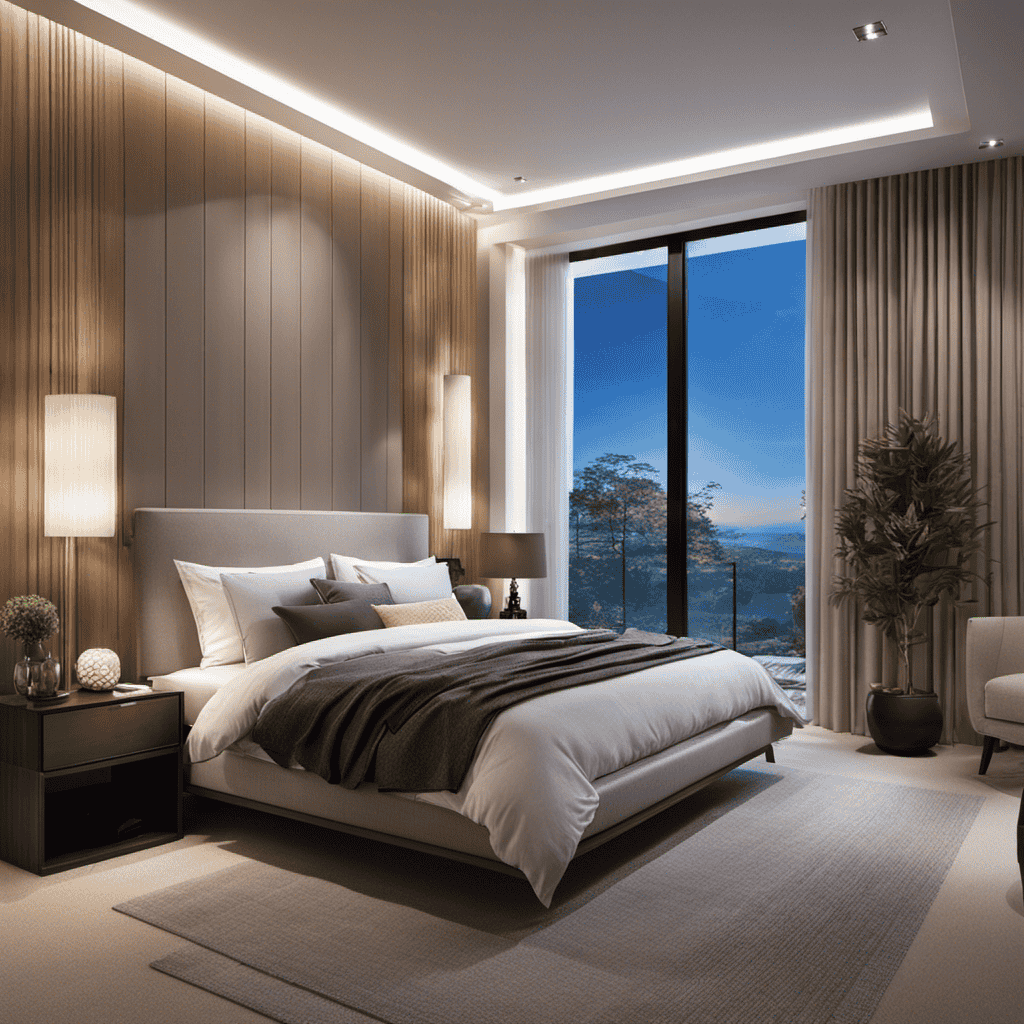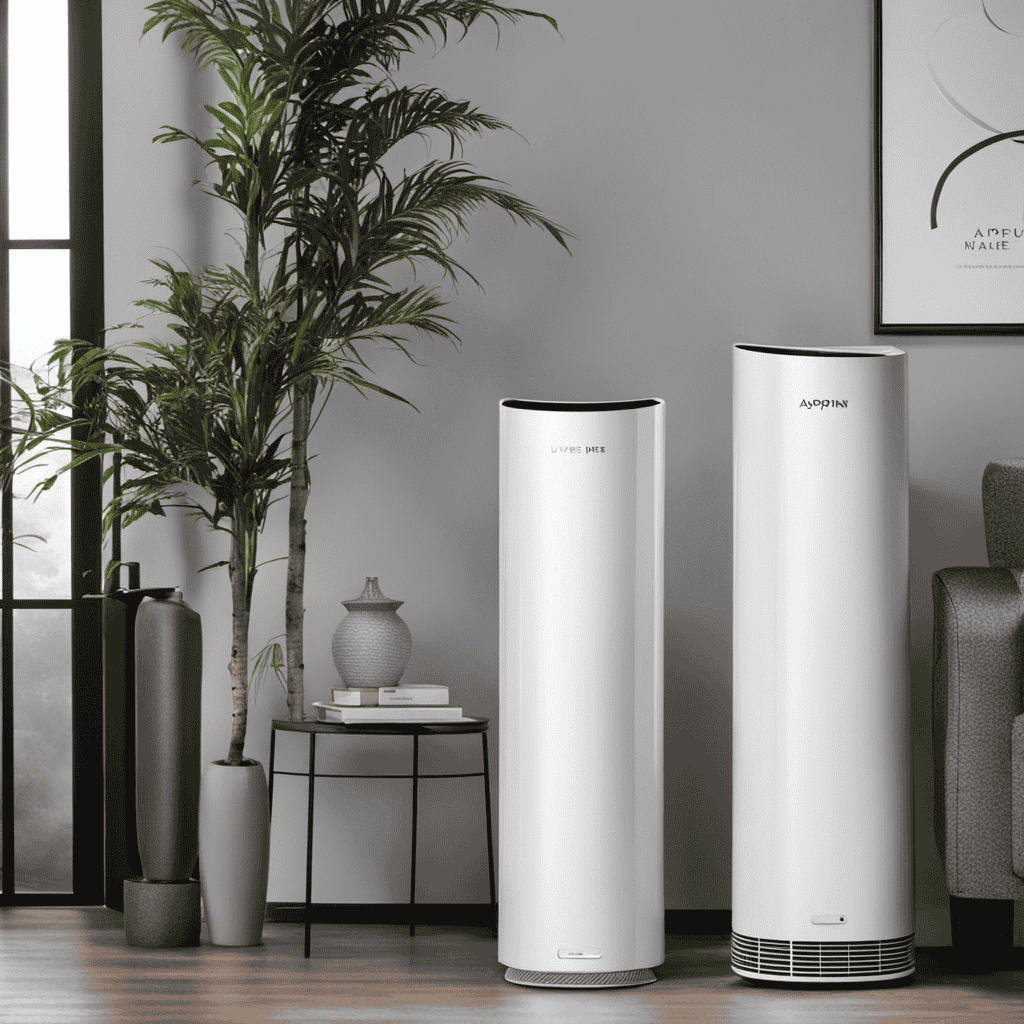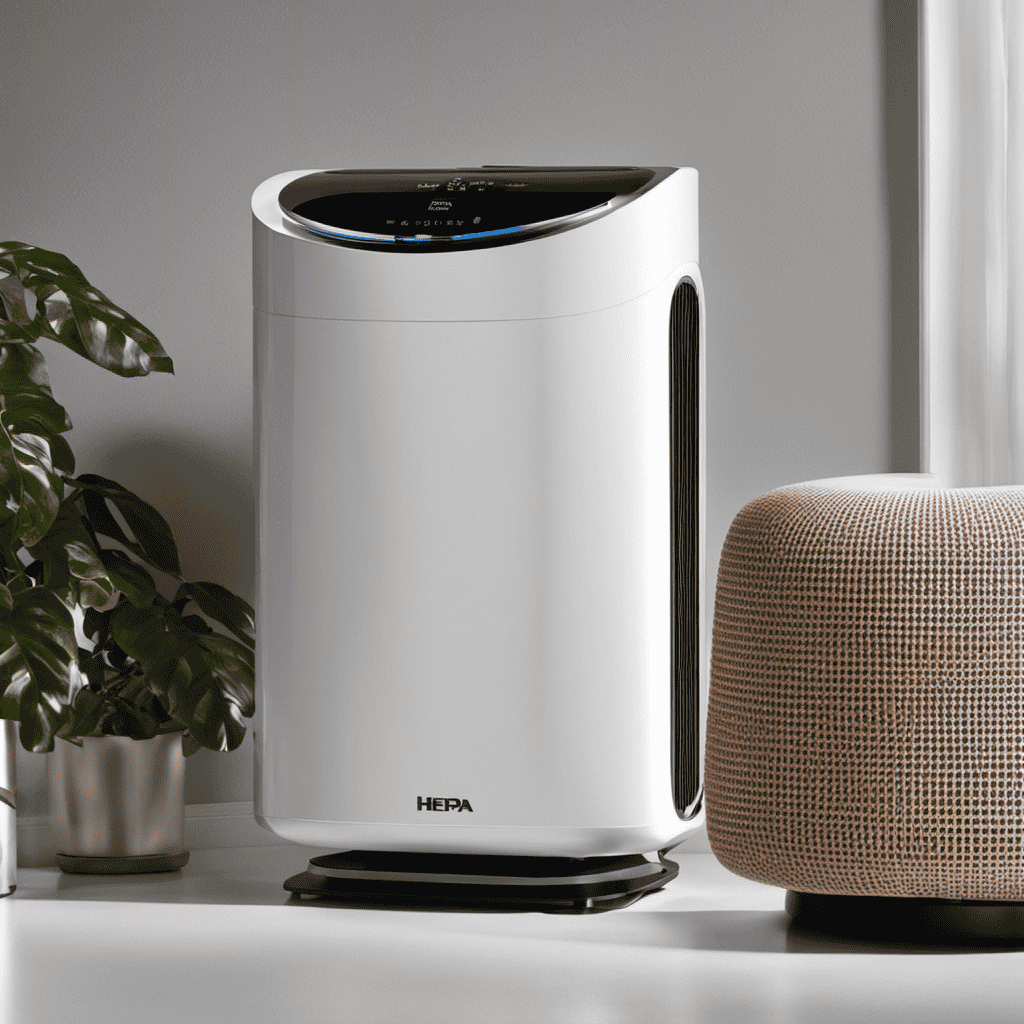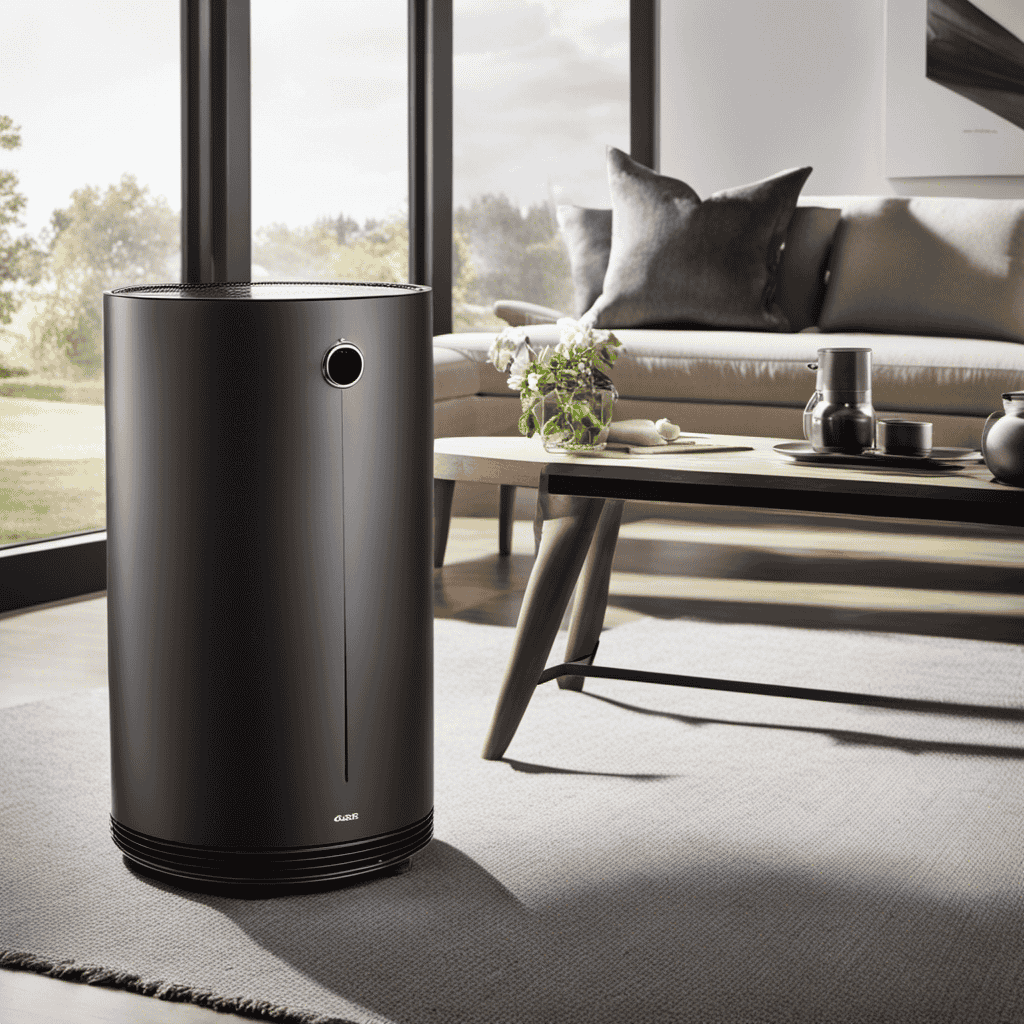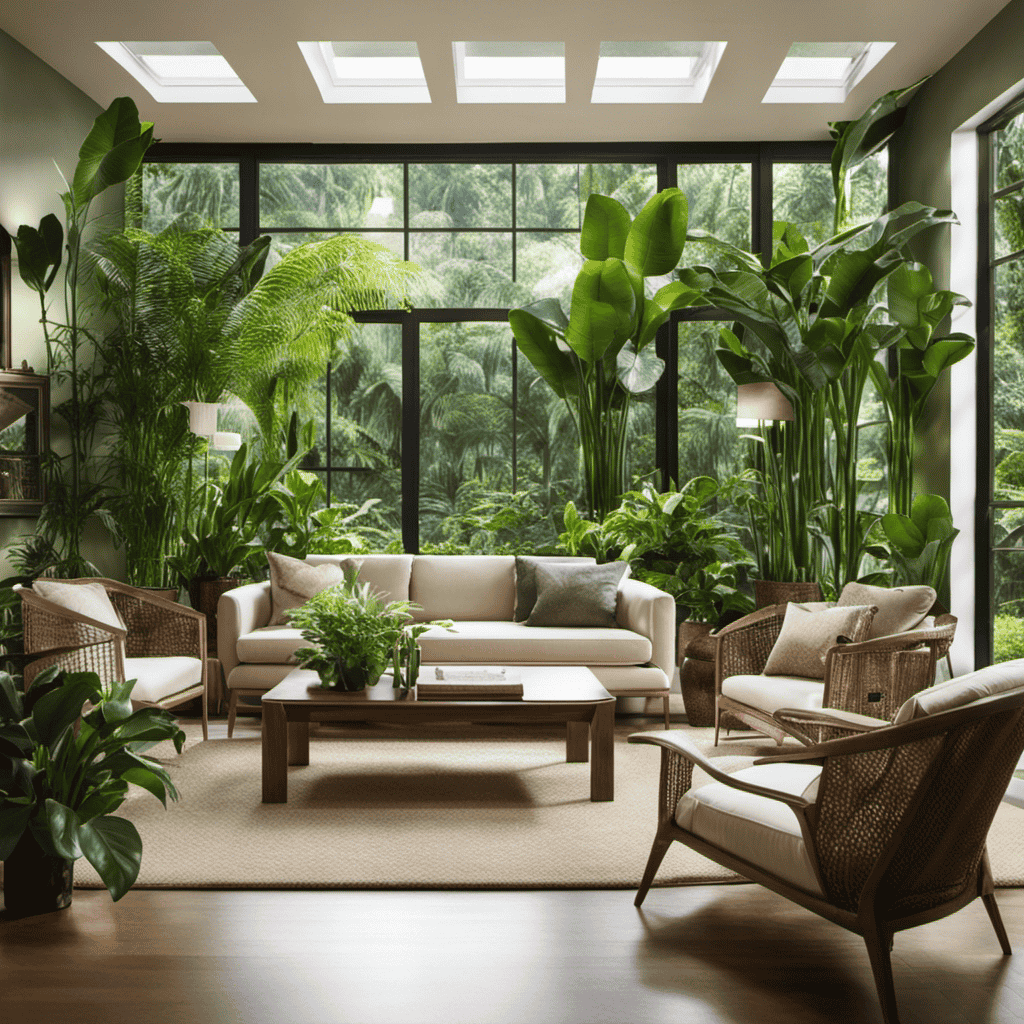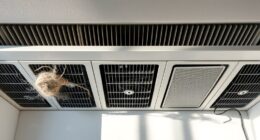Have you ever been curious about how air purifiers function? Allow me to provide you with the answers you’ve been seeking.
In this article, I’ll delve into the fascinating world of air purifiers and uncover their true function. From improving indoor air quality to providing allergy relief, these devices have become essential in our quest for cleaner, healthier air.
So, sit back, relax, and get ready to discover the ins and outs of air purifiers, and why they’re a must-have in any home.
Key Takeaways
- Air purifiers improve indoor air quality by removing harmful pollutants such as dust, pollen, pet dander, and mold spores.
- They alleviate symptoms and improve respiratory health for individuals with asthma or allergies.
- Air purifiers eliminate unpleasant odors like smoke or cooking smells.
- Different types of air purifiers use various filtration technologies, such as HEPA filters, ionizers, or UV-C lights, to effectively capture and trap particles, kill germs and bacteria, and remove harmful gases and odors.
Benefits of Using an Air Purifier
Using an air purifier can greatly improve the quality of the air I breathe in my home. The effectiveness of an air purifier in removing harmful pollutants from the air has been extensively researched. Studies have shown that air purifiers can effectively filter out particles such as dust, pollen, pet dander, and even mold spores, making the air cleaner and healthier to breathe.
This is especially beneficial for individuals with respiratory health conditions, such as asthma or allergies. By reducing the presence of these irritants in the air, air purifiers can help alleviate symptoms and improve overall respiratory health.
Additionally, air purifiers can also eliminate unpleasant odors, such as smoke or cooking smells, creating a more pleasant and comfortable living environment.
Overall, the impact of using an air purifier on respiratory health is significant and can greatly benefit those who suffer from respiratory issues.
How Air Purifiers Improve Indoor Air Quality
To improve the quality of the air indoors, you’ll find that air purifiers are highly effective.
Research has shown that air purifiers can significantly reduce the levels of indoor air pollutants, such as dust, pollen, pet dander, and mold spores.
These devices work by drawing in the air from the surrounding environment and passing it through a series of filters that capture and trap these harmful particles.
The effectiveness of an air purifier largely depends on factors such as the size of the room and the type of filters used.
However, it is important to note that regular maintenance is crucial for optimal performance.
This includes cleaning or replacing filters regularly and keeping the purifier clean to prevent the buildup of contaminants.
Understanding the Different Types of Air Purifiers
When it comes to understanding the different types of air purifiers, you’ll find that there are several options available on the market. To help you navigate through the various choices, I’ve compiled a table comparing three popular brands and their cost.
| Brand | Type | Cost |
|---|---|---|
| Brand A | HEPA Filter | $100 |
| Brand B | Ionizer | $150 |
| Brand C | UV-C Light | $200 |
Brand A offers a HEPA filter, which is known for its effectiveness in removing particles as small as 0.3 microns. Brand B utilizes an ionizer to charge particles and make them easier to capture. Brand C uses UV-C light to kill germs and bacteria.
In terms of cost, Brand A is the most affordable option at $100, followed by Brand B at $150, and Brand C at $200. However, it’s important to consider not only the initial cost but also the cost of replacement filters or parts in the long run.
Key Features to Consider When Choosing an Air Purifier
When it comes to choosing an air purifier, there are two key points that should be considered: important filtration technologies and room size compatibility.
Understanding the different filtration technologies available can help determine the effectiveness of the air purifier in removing pollutants from the air.
Additionally, considering the size of the room where the air purifier will be used is crucial in ensuring that it can effectively clean the air in that space.
Important Filtration Technologies
You should consider using an air purifier with important filtration technologies to effectively control indoor pollution and improve the quality of the air you breathe.
Indoor pollution is a growing concern, with various sources such as dust, pet dander, allergens, and volatile organic compounds contributing to poor air quality. The right air purifier can help eliminate these pollutants and provide a healthier living environment.
When choosing an air purifier, look for technologies like HEPA (High-Efficiency Particulate Air) filters that can trap particles as small as 0.3 microns, including pollen, mold spores, and dust mites. Activated carbon filters are also important as they can absorb harmful gases and odors.
Additionally, consider air purifiers with UV-C light technology, which can kill bacteria and viruses, further enhancing air quality in your home.
Room Size Compatibility
In my previous subtopic, I discussed the important filtration technologies used in air purifiers.
Now, let’s shift our focus to the compatibility of air purifiers with different room sizes. It’s essential to consider the room size limitations of an air purifier to ensure optimal performance.
Here are a few key points to understand:
-
Compact Design: Some air purifiers are specifically designed for small rooms, making them ideal for bedrooms or offices.
-
Medium-Sized Rooms: Certain air purifiers are suitable for medium-sized rooms, providing efficient air purification for living rooms or kitchens.
-
Large Spaces: Air purifiers with high CADR (Clean Air Delivery Rate) are recommended for large spaces like open-concept living areas or conference rooms.
-
Multiple Units: In situations where the room exceeds the purifier’s capacity, using multiple units strategically can improve overall air quality.
Understanding the room size limitations of air purifiers is crucial for achieving the desired results.
Now, let’s explore the role of air purifiers in allergy relief.
The Role of Air Purifiers in Allergy Relief
When it comes to improving indoor air quality and removing airborne allergens, air purifiers play a crucial role. These devices are designed to filter out harmful particles, such as dust, pet dander, pollen, and mold spores, thereby reducing the risk of allergic reactions and respiratory issues.
Through thorough research and analysis, it has been shown that air purifiers can significantly reduce the presence of allergens in the air, leading to a healthier and more comfortable indoor environment.
Airborne Allergen Removal
An air purifier can effectively remove airborne allergens, such as pollen and pet dander, from the surrounding environment. This is achieved through the use of filters that capture and trap these allergens, preventing them from circulating in the air we breathe.
Maintaining an air purifier is essential to ensure its effectiveness in allergen removal. Regularly cleaning or replacing the filters is necessary to prevent them from becoming clogged and losing their efficiency. Additionally, keeping the air purifier in a clean environment and following the manufacturer’s instructions for maintenance can help optimize its performance.
Improved Indoor Air Quality
Regularly cleaning or replacing filters in my air purifier can greatly improve indoor air quality by effectively removing allergens and maintaining the purifier’s efficiency.
Research has shown that air purifiers can be highly effective in reducing airborne pollutants such as dust, pollen, pet dander, and mold spores. By capturing these particles, air purifiers can help alleviate symptoms of allergies and asthma, making the indoor environment much more comfortable and healthy.
In addition to allergen removal, air purifiers offer numerous benefits. They can help eliminate unpleasant odors from cooking, smoking, or pets, and can even filter out harmful volatile organic compounds (VOCs).
Overall, investing in an air purifier can have a significant positive impact on the quality of the air we breathe, leading to improved health and well-being.
Maintaining and Cleaning Your Air Purifier for Optimal Performance
To keep your air purifier working at its best, make sure you regularly clean and maintain it. Cleaning and maintaining your air purifier is essential for optimal performance and to ensure that it continues to effectively remove pollutants from your indoor air.
Here are some cleaning tips and regular maintenance practices to keep in mind:
- Vacuum the external surfaces of the air purifier regularly to remove dust and debris.
- Clean or replace the air filters according to the manufacturer’s instructions to maintain their efficiency.
- Wipe down the control panel and buttons with a damp cloth to remove any dirt or grime.
- Check the fan and motor for any signs of dust accumulation and clean them if necessary.
Frequently Asked Questions
How Much Electricity Does an Air Purifier Consume?
An air purifier consumes varying amounts of electricity depending on its size, features, and usage. Factors such as fan speed, filter type, and room size can affect energy consumption and electricity usage.
Can Air Purifiers Remove All Types of Pollutants From the Air?
Air purifiers are effective in removing various types of pollutants from the air. I once had a purifier with a HEPA filter that significantly reduced allergens in my home, proving its effectiveness.
Do Air Purifiers Produce Any Harmful Byproducts While Operating?
Air purifiers do not produce harmful emissions or have a significant environmental impact while operating. They are designed to remove pollutants from the air, improving indoor air quality without negative side effects.
Can Air Purifiers Eliminate Cooking Odors and Cigarette Smoke?
Air purifiers are effective at eliminating cooking odors and cigarette smoke. They work by filtering out airborne particles and pollutants, improving indoor air quality. Regular air purifier maintenance ensures optimal performance and maximizes the benefits of using an air purifier.
Are Air Purifiers Effective in Reducing the Spread of Airborne Viruses and Bacteria?
Air purifiers are effective in reducing the spread of airborne viruses and bacteria. They improve indoor air quality and provide numerous benefits for respiratory health. Studies show a 99.97% removal rate of airborne particles.
Conclusion
In conclusion, it’s clear that air purifiers are an essential addition to any home or office.
While they claim to improve air quality and alleviate allergies, it’s ironic that they often fall short in delivering on these promises.
Despite their sleek designs and advanced technology, air purifiers seem to be more of a placebo than a true solution.
So, if you’re looking for a quick fix to your air quality woes, you might want to reconsider investing in one of these fancy gadgets and focus on natural remedies instead.
